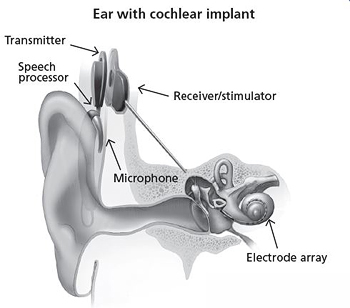 Cochlear Implants
Cochlear Implants
A cochlear implant is a small, complex electronic device that can help to provide a sense of sound to a person who has severe to profound hearing loss. The implant consists of an external portion that sits behind the ear and a second portion that is surgically placed under the skin (see figure). An implant has the following parts:
- A microphone, which picks up sound from the environment.
- A speech processor, which selects and arranges sounds picked up by the microphone.
- A transmitter and receiver/stimulator, which receive signals from the speech processor and convert them into electric impulses.
- An electrode array, which is a group of electrodes that collects the impulses from the stimulator and sends them to different regions of the auditory nerve.
An implant does not restore normal hearing. Instead, it can give a deaf person a useful representation of sounds in the environment and help him or her to understand speech.
Webinar Recording: Cochlear Implants: Increasing Awareness and Access (October 15, 2020)
Read more about this event.
How does a cochlear implant work?
A cochlear implant is very different from a hearing aid. Hearing aids amplify sounds so they may be detected by damaged ears. Cochlear implants bypass damaged portions of the ear and directly stimulate the auditory nerve. Signals generated by the implant are sent by way of the auditory nerve to the brain, which recognizes the signals as sound. Hearing through a cochlear implant is different from normal hearing and takes time to learn or relearn. However, it allows many people to recognize warning signals, understand other sounds in the environment, and understand speech in person or over the telephone.
Who gets cochlear implants?
Children and adults who are deaf or have severe to profound hearing loss can be fitted for cochlear implants. As of December 2012, approximately 324,200 registered devices have been implanted worldwide. In the United States, roughly 58,000 devices have been implanted in adults and 38,000 in children. (Estimates provided by the U.S. Food and Drug Administration [FDA], as reported by cochlear implant manufacturers.)
The FDA first approved cochlear implants in the mid-1980s to treat hearing loss in adults. Since 2000, cochlear implants have been FDA-approved for use in eligible children beginning at 12 months of age. For young children who are deaf or have severe to profound hearing loss, using a cochlear implant while they are young exposes them to sounds during an optimal period to develop speech and language skills. Research has shown that when these children receive a cochlear implant followed by intensive therapy before they are 18 months old, they are better able to hear, comprehend sound and music, and speak than their peers who receive implants when they are older. Studies have also shown that eligible children who receive a cochlear implant before 18 months of age develop language skills at a rate comparable to children with normal hearing, and many succeed in mainstream classrooms.
Some adults who have lost all or most of their hearing later in life can also benefit from cochlear implants. They learn to associate the signals from the implant with sounds they remember, including speech, without requiring any visual cues such as those provided by lipreading or sign language.
How does someone receive a cochlear implant?
Use of a cochlear implant requires both a surgical procedure and significant therapy to learn or relearn the sense of hearing. Not everyone performs at the same level with this device. The decision to receive an implant should involve discussions with medical specialists, including an experienced cochlear-implant surgeon. The process can be expensive. For example, a person’s health insurance may cover the expense, but not always. Some individuals may choose not to have a cochlear implant for a variety of personal reasons. Surgical implantations are almost always safe, although complications are a risk factor, just as with any kind of surgery. An additional consideration is learning to interpret the sounds created by an implant. This process takes time and practice. Speech-language pathologists and audiologists are frequently involved in this learning process. Prior to implantation, all of these factors need to be considered.
What does the future hold for cochlear implants?
The NIDCD supports research to enhance the benefits of cochlear implants. Scientists are exploring whether using a shortened electrode array, inserted into a portion of the cochlea, for example, can help individuals whose hearing loss is limited to the higher frequencies while preserving their hearing of lower frequencies. Researchers also are looking at the potential benefits of pairing a cochlear implant in one ear with either another cochlear implant or a hearing aid in the other ear.
Manufacturers
Discuss your options with your hearing health care team. Evaluate information about reliability, performance, and reputation of each cochlear implant manufacturer. Compare features to determine which suits your lifestyle.
Ask your audiologist and cochlear implant surgeon about each device manufacturer. Ask questions about warranties and how you will be supported in the future; for example, technology upgrades.
There are three cochlear implant manufacturers who market their products in the United States.
Other Implantable Devices
There are some types of conductive hearing losses that can be surgically corrected (e.g., fixing a hole in the eardrum or one of the middle ear bones) or improved with hearing aids. Other types of conductive hearing losses can be improved with implantable devices:
- An implanted middle ear device
- A surgically implanted, osseointegrated device (for example, the Baha or Ponto System)
Implantable middle ear hearing devices are designed to help increase the transmission of sound vibrations reaching the inner ear. Middle ear implants involve a small prosthesis attached to one of the bones of the middle ear. Rather than amplifying the sound traveling to the eardrum (as with a hearing aid), these prostheses help move the bones directly.
Osseointegrated devices are also treatment options for people with conductive or mixed hearing loss. These implants are surgically embedded to the outside of a person’s skull, behind the ear. A tiny titanium abutment is anchored to the skull to which an external processor is attached. When the microphone on the processor picks up incoming sounds, the processor transmits these sounds via the abutment to the inner ear through skull vibrations.

